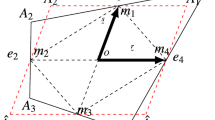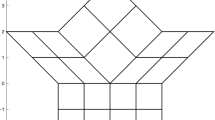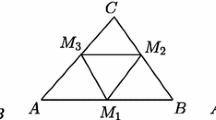Abstract
We present a novel family of C1 quadrilateral finite elements, which define global C1 spaces over a general quadrilateral mesh with vertices of arbitrary valency. The elements extend the construction by Brenner and Sung (J. Sci. Comput. 22(1-3), 83-118, 2005), which is based on polynomial elements of tensor-product degree p ≥ 6, to all degrees p ≥ 3. The proposed C1 quadrilateral is based upon the construction of multi-patch C1 isogeometric spaces developed in Kapl et al. (Comput. Aided Geometr. Des. 69, 55–75 2019). The quadrilateral elements possess similar degrees of freedom as the classical Argyris triangles, developed in Argyris et al. (Aeronaut. J. 72(692), 701–709 1968). Just as for the Argyris triangle, we additionally impose C2 continuity at the vertices. In contrast to Kapl et al. (Comput. Aided Geometr. Des. 69, 55–75 2019), in this paper, we concentrate on quadrilateral finite elements, which significantly simplifies the construction. We present macro-element constructions, extending the elements in Brenner and Sung (J. Sci. Comput. 22(1–3), 83–118 2005), for polynomial degrees p = 3 and p = 4 by employing a splitting into 3 × 3 or 2 × 2 polynomial pieces, respectively. We moreover provide approximation error bounds in \(L^{\infty }\), L2, H1 and H2 for the piecewise-polynomial macro-element constructions of degree p ∈{3,4} and polynomial elements of degree p ≥ 5. Since the elements locally reproduce polynomials of total degree p, the approximation orders are optimal with respect to the mesh size. Note that the proposed construction combines the possibility for spline refinement (equivalent to a regular splitting of quadrilateral finite elements) as in Kapl et al. (Comput. Aided Geometr. Des. 69, 55–75 30) with the purely local description of the finite element space and basis as in Brenner and Sung (J. Sci. Comput. 22(1–3), 83–118 2005). In addition, we describe the construction of a simple, local basis and give for p ∈{3,4,5} explicit formulas for the Bézier or B-spline coefficients of the basis functions. Numerical experiments by solving the biharmonic equation demonstrate the potential of the proposed C1 quadrilateral finite element for the numerical analysis of fourth order problems, also indicating that (for p = 5) the proposed element performs comparable or in general even better than the Argyris triangle with respect to the number of degrees of freedom.
Article PDF
Similar content being viewed by others
Avoid common mistakes on your manuscript.
References
Argyris, J. H., Fried, I., Scharpf, D. W.: The TUBA family of plate elements for the matrix displacement method. Aeronaut. J. 72(692), 701–709 (1968)
Arnold, D., Boffi, D., Falk, R.: Approximation by quadrilateral finite elements. Math. Comput. 71(239), 909–922 (2002)
Bartezzaghi, A., Dedè, L., Quarteroni, A.: Isogeometric analysis of high order partial differential equations on surfaces. Comput. Methods Appl. Mech. Eng. 295, 446–469 (2015)
Bell, K.: A refined triangular plate bending finite element. Int. J. Numer. Methods Eng. 1(1), 101–122 (1969)
Bercovier, M., Matskewich, T.: Smooth Bézier surfaces over unstructured quadrilateral meshes. Lecture Notes of the Unione Matematica Italiana. Springer (2017)
Blidia, A., Mourrain, B., Villamizar, N.: G1-smooth splines on quad meshes with 4-split macro-patch elements. Comput. Aided Geometr. Des. 52–53, 106–125 (2017)
Bogner, F. K., Fox, R. L., Schmit, L. A.: The generation of interelement compatible stiffness and mass matrices by the use of interpolation formulae. Proc. Conf. Matrix Methods in Struct. Mech., AirForce Inst. of Tech., Wright Patterson AF Base Ohio (1965)
Brenner, S. C., Scott, R.: The mathematical theory of finite element methods, vol. 15. Springer Science & Business Media (2007)
Brenner, S. C., Sung, L.-Y.: C0 interior penalty methods for fourth order elliptic boundary value problems on polygonal domains. J. Sci. Comput. 22(1-3), 83–118 (2005)
Buchegger, F., Jüttler, B., Mantzaflaris, A.: Adaptively refined multi-patch B-splines with enhanced smoothness. Appl. Math. Comput. 272, 159–172 (2016)
Chan, C. L., Anitescu, C., Rabczuk, T.: Isogeometric analysis with strong multipatch C1-coupling. Comput. Aided Geometr. Des. 62, 294–310 (2018)
Chan, C. L., Anitescu, C., Rabczuk, T.: Strong multipatch C1-coupling for isogeometric analysis on 2D and 3D domains. Comput. Methods Appl. Mech. Engrg. 357, 112599 (2019)
Ciarlet, P. G.: The finite element method for elliptic problems, vol. 40. Siam (2002)
Collin, A., Sangalli, G., Takacs, T.: Analysis-suitable G1 multi-patch parametrizations for C1 isogeometric spaces. Comput. Aided Geometr. Des. 47, 93–113 (2016)
Cottrell, J. A., Hughes, T. J. R., Bazilevs, Y.: Isogeometric analysis: Toward Integration of CAD and FEA. Wiley, Chichester (2009)
Fraeijs De Veubeke, B.: A conforming finite element for plate bending. Int. J. Solids Struct. 4(1), 95–108 (1968)
Durán, R. G., Hernández, E., Hervella-Nieto, L., Liberman, E., Rodríguez, R: Error estimates for low-order isoparametric quadrilateral finite elements for plates. SIAM J. Numer. Anal. 41(5), 1751–1772 (2003)
Fischer, P., Klassen, M., Mergheim, J., Steinmann, P., Müller, R.: Isogeometric analysis of 2D gradient elasticity. Comput. Mech. 47(3), 325–334 (2011)
Gómez, H., Calo, V. M., Bazilevs, Y., Hughes, T. J. R.: Isogeometric analysis of the Cahn–Hilliard phase-field model. Comput. Methods Appl. Mech. Eng. 197(49), 4333–4352 (2008)
Gómez, H., Hughes, T. J. R., Nogueira, X., Calo, V. M.: Isogeometric analysis of the isothermal Navier–Stokes–Korteweg equations. Comput. Methods Appl. Mech. Eng. 199(25), 1828–1840 (2010)
Gregory, J. A., Mahn, J. M.: Geometric continuity and convex combination patches. Comput. Aided Geometr. Des. 4(1-2), 79–89 (1987)
Grošelj, J., Kapl, M., Knez, M., Takacs, T., Vitrih, V.: A super-smooth C1 spline space over planar mixed triangle and quadrilateral meshes. Comput. Math. Appl. 80(12), 2623–2643 (2020)
Hughes, T. J. R., Cottrell, J. A., Bazilevs, Y.: Isogeometric analysis: CAD, finite elements, NURBS, exact geometry and mesh refinement. Comput. Methods Appl. Mech. Eng. 194(39-41), 4135–4195 (2005)
Hughes, T. J. R., Sangalli, G., Takacs, T., Toshniwal, D.: Chapter 8 - Smooth multi-patch discretizations in isogeometric analysis, Geometric Partial Differential Equations - Part II (Andrea Bonito and Ricardo H. Nochetto, eds.), Handbook of Numerical Analysis, vol. 22. Elsevier, pp. 467–543 (2021)
Jüttler, B.: The dual basis functions for the Bernstein polynomials. Adv. Comput. Math. 8(4), 345–352 (1998)
Kapl, M., Buchegger, F., Bercovier, M., Jüttler, B.: Isogeometric analysis with geometrically continuous functions on planar multi-patch geometries. Comput. Methods Appl. Mech. Eng. 316, 209–234 (2017)
Kapl, M., Sangalli, G., Takacs, T.: Dimension and basis construction for analysis-suitable G1 two-patch parameterizations. Comput. Aided Geometr. Des 52–53, 75–89 (2017)
Kapl, M., Sangalli, G., Takacs, T.: Construction of analysis-suitable G1 planar multi-patch parameterizations. Comput. Aided Des. 97, 41–55 (2018)
Kapl, M., Sangalli, G., Takacs, T.: Isogeometric analysis with C1 functions on unstructured quadrilateral meshes. SMAI J. Comput. Math. 5, 67–86 (2019)
Kapl, M., Sangalli, G., Takacs, T.: An isogeometric C1 subspace on unstructured multi-patch planar domains. Comput. Aided Geometr. Des. 69, 55–75 (2019)
Kapl, M., Vitrih, V., Jüttler, B., Birner, K.: Isogeometric analysis with geometrically continuous functions on two-patch geometries. Comput. Math. Appl. 70(7), 1518–1538 (2015)
Karčiauskas, K., Nguyen, T., Peters, J.: Generalizing bicubic splines for modeling and IGA with irregular layout. Comput. Aided Des. 70, 23–35 (2016)
Karčiauskas, K., Peters, J.: Refinable G1 functions on G1 free-form surfaces. Comput. Aided Geometr. Des. 54, 61–73 (2017)
Karčiauskas, K., Peters, J.: Refinable bi-quartics for design and analysis. Comput. Aided Des., 204–214 (2018)
Kiendl, J., Bazilevs, Y., Hsu, M. -C., Wüchner, R., Bletzinger, K. -U.: The bending strip method for isogeometric analysis of Kirchhoff-Love shell structures comprised of multiple patches. Comput. Methods Appl. Mech. Eng. 199 (35), 2403–2416 (2010)
Kiendl, J., Bletzinger, K. -U., Linhard, J., Wüchner, R.: Isogeometric shell analysis with Kirchhoff-Love elements. Comput. Methods Appl. Mech. Eng. 198(49), 3902–3914 (2009)
Lai, M. -J., Schumaker, L. L.: Spline functions on triangulations. Cambridge University Press (2007)
Matskewich, T.: Construction of C1 surfaces by assembly of quadrilateral patches under arbitrary mesh topology. Ph.D. thesis, Hebrew University of Jerusalem (2001)
Mourrain, B., Vidunas, R., Villamizar, N.: Dimension and bases for geometrically continuous splines on surfaces of arbitrary topology. Comput. Aided Geometr. Des. 45, 108–133 (2016)
Nguyen, T., Karčiauskas, K., Peters, J.: C1 finite elements on non-tensor-product 2d and 3d manifolds. Appl. Math. Comput. 272, 148–158 (2016)
Nguyen, T., Peters, J.: Refinable C1 spline elements for irregular quad layout. Comput. Aided Geometr. Des. 43, 123–130 (2016)
Niiranen, J., Khakalo, S., Balobanov, V., Niemi, A. H.: Variational formulation and isogeometric analysis for fourth-order boundary value problems of gradient-elastic bar and plane strain/stress problems. Comput. Methods Appl. Mech. Engrg. 308, 182–211 (2016)
Peters, J.: Smooth mesh interpolation with cubic patches. Comput. Aided Des. 22(2), 109–120 (1990)
Peters, J.: Smooth interpolation of a mesh of curves. Constr. Approx. 7(1), 221–246 (1991)
Peters, J.: Geometric continuity, pp. 193–227. Handbook of computer aided geometric design, Amsterdam (2002)
Prautzsch, H., Boehm, W., Paluszny, M.: Bézier and B- spline techniques. Springer, New York (2002)
Reif, U.: Biquadratic G-spline surfaces. Comput. Aided Geometr. Des. 12(2), 193–205 (1995)
Sander, G.: Bornes superieures et inferieures dans l’analyse matricielle des plaques en flexion-torsion. Bull. Soc. r. Sci. Liege 33, 456–494 (1964)
Sangalli, G., Takacs, T., Vázquez, R.: Unstructured spline spaces for isogeometric analysis based on spline manifolds. Comput. Aided Geometr. Des. 47, 61–82 (2016)
Schumaker, L. L.: Spline functions: Basic Theory. Cambridge University Press, Cambridge (2007)
Sogn, J., Takacs, S.: Robust multigrid solvers for the biharmonic problem in isogeometric analysis. Comput. Math. Appl. 77(1), 105–124 (2019)
Tagliabue, A., Dedè, L., Quarteroni, A.: Isogeometric analysis and error estimates for high order partial differential equations in fluid dynamics. Comput. Fluids 102, 277–303 (2014)
Toshniwal, D., Speleers, H., Hughes, T. J. R.: Smooth cubic spline spaces on unstructured quadrilateral meshes with particular emphasis on extraordinary points: Geometric design and isogeometric analysis considerations. Comput. Methods Appl. Mech. Eng. 327, 411–458 (2017)
Acknowledgements
We would like to thank the reviewers for their diligence and for providing valuable suggestions which helped improving the article.
Funding
Open access funding provided by Johannes Kepler University Linz. The research of G. Sangalli is partially supported by the European Research Council through the FP7 Ideas Consolidator Grant HIGEOM n.616563, and by the Italian Ministry of Education, University and Research (MIUR) through the “Dipartimenti di Eccellenza Program (2018-2022) - Dept. of Mathematics, University of Pavia”. G. Sangalli is a member of the Gruppo Nazionale Calcolo Scientifico-Istituto Nazionale di Alta Matematica (GNCS-INDAM). The research of M. Kapl is partially supported by the Austrian Science Fund (FWF) through the project P 33023-N. The research of T. Takacs is partially supported by the Austrian Science Fund (FWF) and the government of Upper Austria through the project P 30926-NBL. This support is gratefully acknowledged.
Author information
Authors and Affiliations
Corresponding author
Additional information
Communicated by: Lourenço Beirão da Veiga
Publisher’s note
Springer Nature remains neutral with regard to jurisdictional claims in published maps and institutional affiliations.
Appendices
Appendix A: Pull-backs of derivatives
In the following, we derive the pull-backs of the partial derivatives ∂1φ, ∂2φ, \(\partial _{1}^{2}\varphi \), ∂1∂2φ and \(\partial _{2}^{2}\varphi \), i.e., their representations in parameters (ξ1,ξ2). We have that
and, after applying the chain rule, obtain
Consequently, we obtain
For second derivatives, the chain rule yields
Thus, having \({\partial _{i}^{2}}\mathrm {F}_{Q,j}=0\) for all i,j ∈{1, 2}, we obtain
where
Appendix B: Precomputations for basis functions
We recall the notation presented in Section ?? and introduce additional precomputable terms. Let
be the vector corresponding to the edge ε(k) and let
then we have
Let moreover
for i,j ∈{1, 2} and k ∈{1, 2, 3, 4}. Here k is considered modulo 4.
2.1 B.1 Precomputations for degree p = 5
For p = 5 we define

and

We moreover define

and
In addition, we define the correction terms
We then have
The functions derived from the coefficient matrices X, \(\mathbf {Y}_{i}^{(k)}\) and \(\mathbf {Z}_{(i,j)}^{(k)}\), i.e., \(\hat {\mathbf {b}}^{p}(\xi _{1})^{T} R^{(k)}\left (\mathbf {X}\right )\hat {\mathbf {b}}^{p}(\xi _{2})\), are constructed in such a way that they satisfy the C2 interpolation conditions at the vertex vk and have vanishing derivatives up to second order at all others. Moreover, they have vanishing function values and gradients along the edges εk+ 1 and εk+ 2. However, their normal derivatives along the edges εk and εk− 1 are (in general) not polynomials of degree four, i.e., they do not satisfy the condition \((\partial _{\mathbf {n}_{\varepsilon ^{(\ell )}}} \varphi \circ \mathbf {F}_{Q})|_{\hat {\varepsilon }^{(\ell )}} \in \mathbb {P}_{4}\) in Eq. ?? for ℓ ∈{k − 1,k}, and their normal derivatives do not vanish at the edge midpoints, i.e., \(\partial _{\mathbf {n}_{\varepsilon ^{(\ell )}}} \varphi (\mathbf {m}_{\varepsilon ^{(\ell )}}) \neq 0\) for ℓ ∈{k − 1,k}. The correction terms in Eq. B.1 are defined in such a way that both conditions are satisfied for the functions \({\beta }_{\mathbf {v},i}^{(k)}\), with i ∈{0, 1, 2, 3, 4, 5}, defined in Eq. ??. The functions for degrees p = 4 and p = 3 are constructed analogously.
2.2 B.2 Precomputations for degree p = 4
For macro-element constructions of degree p = 3 and p = 4 the involved matrices are different from those for degree p = 5. For p = 4 we have


and

as well as
and the correction terms
The matrices \(\mathbf {V}_{i}^{(k)}\), for 0 ≤ i ≤ 5, are then defined as in Eq. B.2.
2.3 B.3 Precomputations for degree p = 3
For p = 3 we have


and

where all matrices are of size 8 × 8 and the dots signify that the matrices are completed with zeros. We moreover have
and the correction terms
The matrices \(\mathbf {V}_{i}^{(k)}\), for 0 ≤ i ≤ 5, are again defined as in Eq. B.2.
Rights and permissions
Open Access This article is licensed under a Creative Commons Attribution 4.0 International License, which permits use, sharing, adaptation, distribution and reproduction in any medium or format, as long as you give appropriate credit to the original author(s) and the source, provide a link to the Creative Commons licence, and indicate if changes were made. The images or other third party material in this article are included in the article's Creative Commons licence, unless indicated otherwise in a credit line to the material. If material is not included in the article's Creative Commons licence and your intended use is not permitted by statutory regulation or exceeds the permitted use, you will need to obtain permission directly from the copyright holder. To view a copy of this licence, visit http://creativecommons.org/licenses/by/4.0/.
About this article
Cite this article
Kapl, M., Sangalli, G. & Takacs, T. A family of C1 quadrilateral finite elements. Adv Comput Math 47, 82 (2021). https://doi.org/10.1007/s10444-021-09878-3
Received:
Accepted:
Published:
DOI: https://doi.org/10.1007/s10444-021-09878-3




